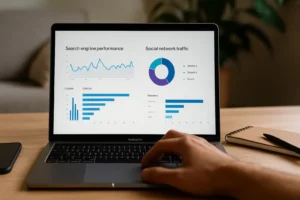In the changing world of digital marketing, understanding the difference between Google Ads and Google AdWords is essential for any effective online advertising strategy. Although often used interchangeably, these two platforms have key distinctions that significantly impact how advertising campaigns should be approached.
In this article, you will discover not only “what is the difference between Google Ads and Google AdWords”, but also how this knowledge can optimize your digital marketing strategies and improve the performance of your campaigns.
History and Evolution
Google AdWords was launched in 2000 as a revolutionary solution for digital advertising, allowing businesses to display ads on the Google search engine. Initially, AdWords offered a simple, text-based, keyword-focused approach. Over time, the platform evolved, expanding its capabilities to include various ad formats and advanced targeting and measurement tools.
The transition of Google AdWords to international Google Ads in 2018 marked an important milestone in this evolution. This change represented not only a name change, but also a restructuring and expansion of services. By exploring the difference between Google Ads and Google AdWords, It is crucial to understand this development as a reflection of Google's adaptation to an increasingly complex and diversified online advertising landscape.
Rebranding and Expansion of Services
The rebranding from Google AdWords to Google Ads was much more than just a name reset; symbolized a significant expansion in the platform's range of services and capabilities. This change is a key piece to understand the difference between Google Ads and Google AdWords. Google Ads was introduced as a more comprehensive and unified platform, designed to encompass not only advertising on the Google search engine, but also on other channels such as YouTube, Google Display Network and Google Play.
This expansion of services reflects how Google has adapted its advertising approach to include more ad formats, such as display and video ads, and new technologies such as artificial intelligence and machine learning for more effective targeting and optimization. When considering the difference between Google Ads and Google AdWords, it is essential to recognize this change as a step towards more diverse, interactive and results-oriented advertising.
Difference between Google ADS and Google AdWords
When investigating the difference between Google Ads and Google AdWords, One of the most significant areas to highlight are the tools and functionalities. Originally, Google AdWords focused primarily on text ads in Google search results. However, with the evolution to Google Ads, the platform expanded its reach to include a variety of advertising formats such as display ads, video ads, and mobile app ads.
This expansion of functionality represents a significant advance in how Google Ads has improved campaign segmentation and personalization capabilities, offering advertisers more sophisticated and diversified tools to reach their target audience.
Additionally, when considering the difference between Google Ads and Google AdWords, it is notable how Google Ads has integrated advanced technologies such as machine learning to optimize advertising campaigns, something that was not as developed in the early stages of AdWords.
Segmentation and Advertising Strategies
While AdWords offered basic targeting options based on keywords and geographic location, Google Ads has taken this to the next level. With Google Ads, advertisers can now take advantage of much more detailed and refined targeting, including specific user interests, browsing behaviors, and even detailed demographic data.
This evolution in targeting and advertising strategies reflects how Google Ads has adapted its services to provide more relevant and personalized advertising campaigns. Understanding this difference between Google Ads and Google AdWords is crucial for any advertiser looking to maximize the impact and efficiency of their campaigns in today's dynamic digital environment.
Interface and User Experience
The difference between Google Ads and Google AdWords It is particularly evident in the user interface and experience. While Google AdWords had a more basic and functional interface, Google Ads has introduced a more intuitive and visually appealing user experience. This evolution reflects a focus on improving accessibility and ease of use, making it easier for advertisers to manage and optimize their campaigns.
The Google Ads interface is designed to be friendlier, with simplified navigation and a clearer presentation of important data and metrics. This change is an integral part of the difference between Google Ads and Google AdWords, highlighting Google's commitment to continually improving the user experience.
Get the most out of Google Ads!
Improve your ad performance, reach your ideal customers, turn every click into a real opportunity, and make your investment count from day one.
Focus on Mobile and Modern Advertising
Google AdWords began at a time when internet browsing was predominantly desktop. However, with the rise of mobile devices, Google Ads has adapted its services to prioritize and optimize advertising on these devices. This transition reflects a shift in consumer trends and the importance of reaching users where they spend most of their time online: on their mobile phones.
The focus on mobile advertising is an essential part of the difference between Google Ads and Google AdWords, signaling how Google has responded to changes in consumer behavior and integrated advanced capabilities for advertising across multiple platforms and devices.
SEO and Google Ads
While Google AdWords focused primarily on paid advertising, Google Ads has evolved to offer tighter integration with SEO strategies. This synergy allows advertisers to not only increase the visibility of their paid ads, but also improve the organic performance of their websites.
The union of SEO and Google Ads reflects how Google has adapted its platform to offer a more holistic and coherent digital marketing solution, marking a significant evolution in the difference between Google Ads and Google AdWords.
Policies and Regulations
Policies and regulations are another aspect where the difference between Google Ads and Google AdWords manifests itself. As time has passed and Google Ads has evolved, new regulations and policies have emerged designed to adapt to a more complex and diversified digital advertising landscape.
These changes reflect an effort to keep online advertising safe, relevant and high quality for users. Understanding how these policies have changed since the days of Google AdWords is crucial for any advertiser, as these regulations directly affect how advertising campaigns should be designed and executed.
Boost your Business with Google Ads
Ready to take your business to the next level? With personalized strategies, detailed analysis and a creative approach, we transform your ideas into successful advertising campaigns. Explore how our experience and knowledge can open a world of possibilities for your brand. Visit our page now and start your journey to digital success!”





